Organization and Management of Healthcare Facility with IT Impact
VerifiedAdded on 2022/08/13
|12
|2774
|14
Report
AI Summary
This report examines the impact of information technology on healthcare, focusing on the organizational structure of 'We Care Hospital' and the implementation of IT for improved patient service. It details the roles of various departments, including the Board of Directors, administration, and diagnostic services. The report explores the HITECH Act of 2009 and its effects on EHR adoption, data security, and hospital revenue. It also addresses HIPAA violations through a case study, outlining the consequences and feasibility plans for data protection, including enterprise-wide approaches, risk assessments, and encryption. The report highlights the pros and cons of IT in patient service, emphasizing the importance of communication and patient-centric care while acknowledging the risks of data breaches. Overall, the report offers a comprehensive analysis of IT's role in modern healthcare, emphasizing the need for robust management and security protocols.
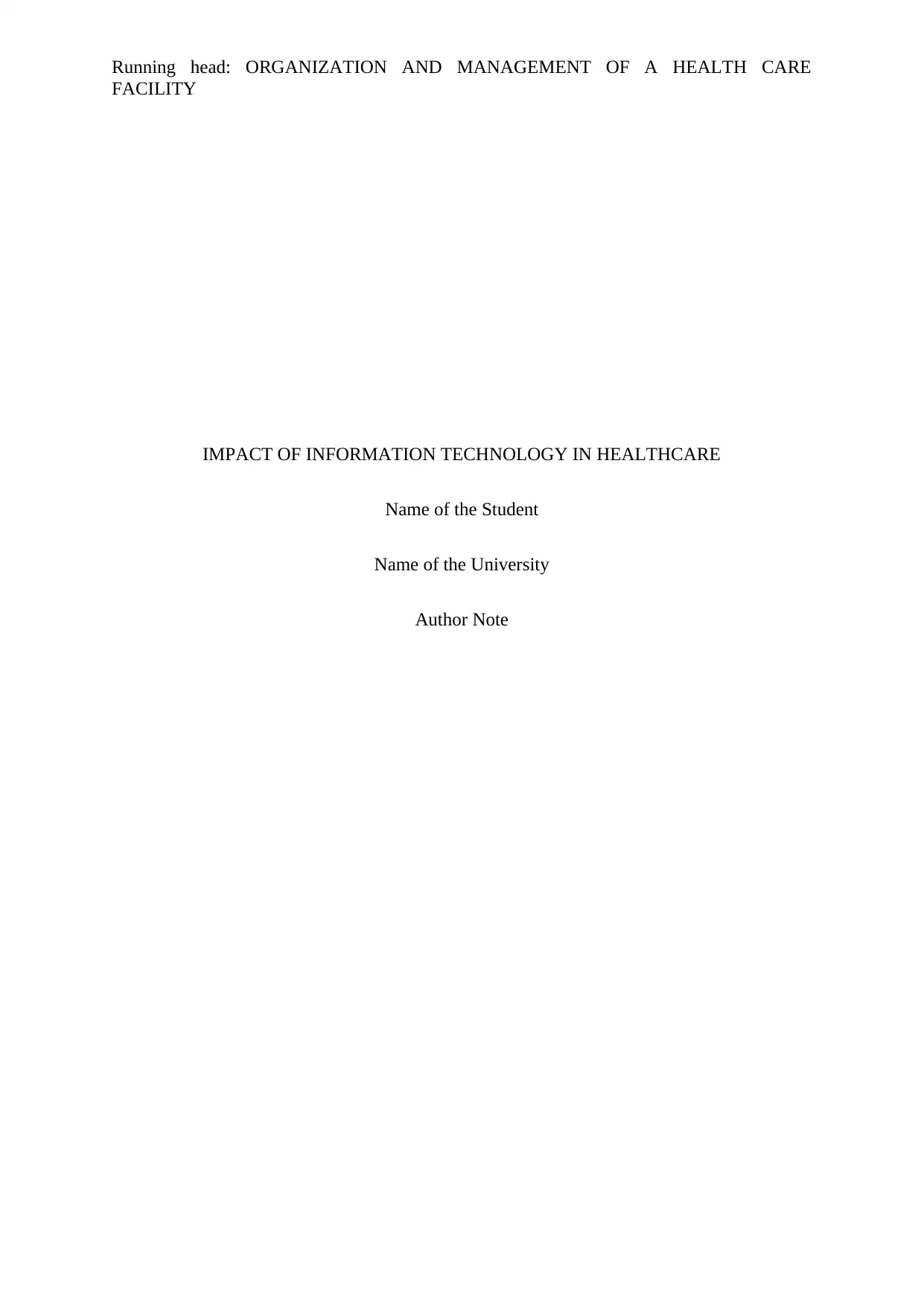
Running head: ORGANIZATION AND MANAGEMENT OF A HEALTH CARE
FACILITY
IMPACT OF INFORMATION TECHNOLOGY IN HEALTHCARE
Name of the Student
Name of the University
Author Note
FACILITY
IMPACT OF INFORMATION TECHNOLOGY IN HEALTHCARE
Name of the Student
Name of the University
Author Note
Paraphrase This Document
Need a fresh take? Get an instant paraphrase of this document with our AI Paraphraser
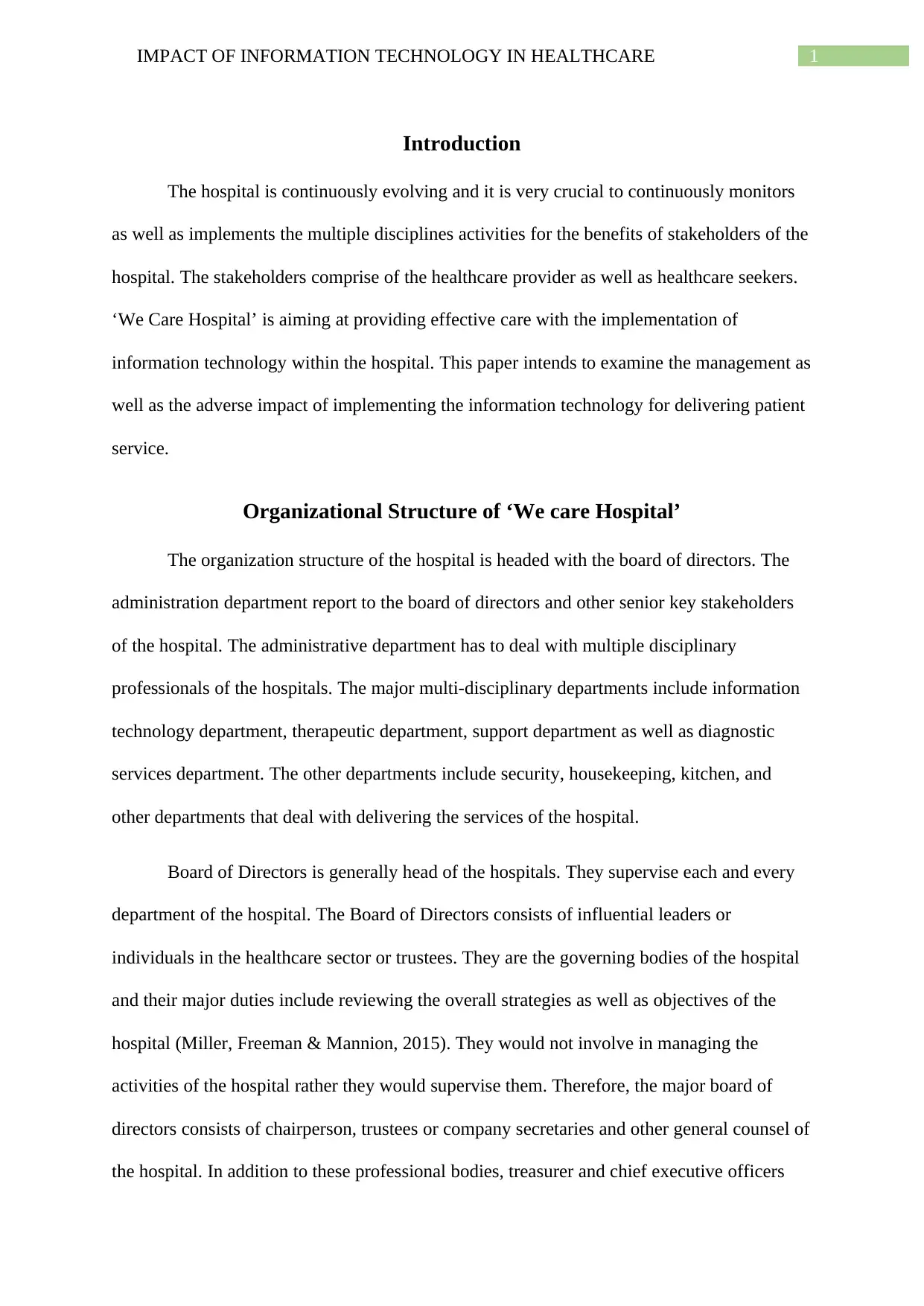
1IMPACT OF INFORMATION TECHNOLOGY IN HEALTHCARE
Introduction
The hospital is continuously evolving and it is very crucial to continuously monitors
as well as implements the multiple disciplines activities for the benefits of stakeholders of the
hospital. The stakeholders comprise of the healthcare provider as well as healthcare seekers.
‘We Care Hospital’ is aiming at providing effective care with the implementation of
information technology within the hospital. This paper intends to examine the management as
well as the adverse impact of implementing the information technology for delivering patient
service.
Organizational Structure of ‘We care Hospital’
The organization structure of the hospital is headed with the board of directors. The
administration department report to the board of directors and other senior key stakeholders
of the hospital. The administrative department has to deal with multiple disciplinary
professionals of the hospitals. The major multi-disciplinary departments include information
technology department, therapeutic department, support department as well as diagnostic
services department. The other departments include security, housekeeping, kitchen, and
other departments that deal with delivering the services of the hospital.
Board of Directors is generally head of the hospitals. They supervise each and every
department of the hospital. The Board of Directors consists of influential leaders or
individuals in the healthcare sector or trustees. They are the governing bodies of the hospital
and their major duties include reviewing the overall strategies as well as objectives of the
hospital (Miller, Freeman & Mannion, 2015). They would not involve in managing the
activities of the hospital rather they would supervise them. Therefore, the major board of
directors consists of chairperson, trustees or company secretaries and other general counsel of
the hospital. In addition to these professional bodies, treasurer and chief executive officers
Introduction
The hospital is continuously evolving and it is very crucial to continuously monitors
as well as implements the multiple disciplines activities for the benefits of stakeholders of the
hospital. The stakeholders comprise of the healthcare provider as well as healthcare seekers.
‘We Care Hospital’ is aiming at providing effective care with the implementation of
information technology within the hospital. This paper intends to examine the management as
well as the adverse impact of implementing the information technology for delivering patient
service.
Organizational Structure of ‘We care Hospital’
The organization structure of the hospital is headed with the board of directors. The
administration department report to the board of directors and other senior key stakeholders
of the hospital. The administrative department has to deal with multiple disciplinary
professionals of the hospitals. The major multi-disciplinary departments include information
technology department, therapeutic department, support department as well as diagnostic
services department. The other departments include security, housekeeping, kitchen, and
other departments that deal with delivering the services of the hospital.
Board of Directors is generally head of the hospitals. They supervise each and every
department of the hospital. The Board of Directors consists of influential leaders or
individuals in the healthcare sector or trustees. They are the governing bodies of the hospital
and their major duties include reviewing the overall strategies as well as objectives of the
hospital (Miller, Freeman & Mannion, 2015). They would not involve in managing the
activities of the hospital rather they would supervise them. Therefore, the major board of
directors consists of chairperson, trustees or company secretaries and other general counsel of
the hospital. In addition to these professional bodies, treasurer and chief executive officers
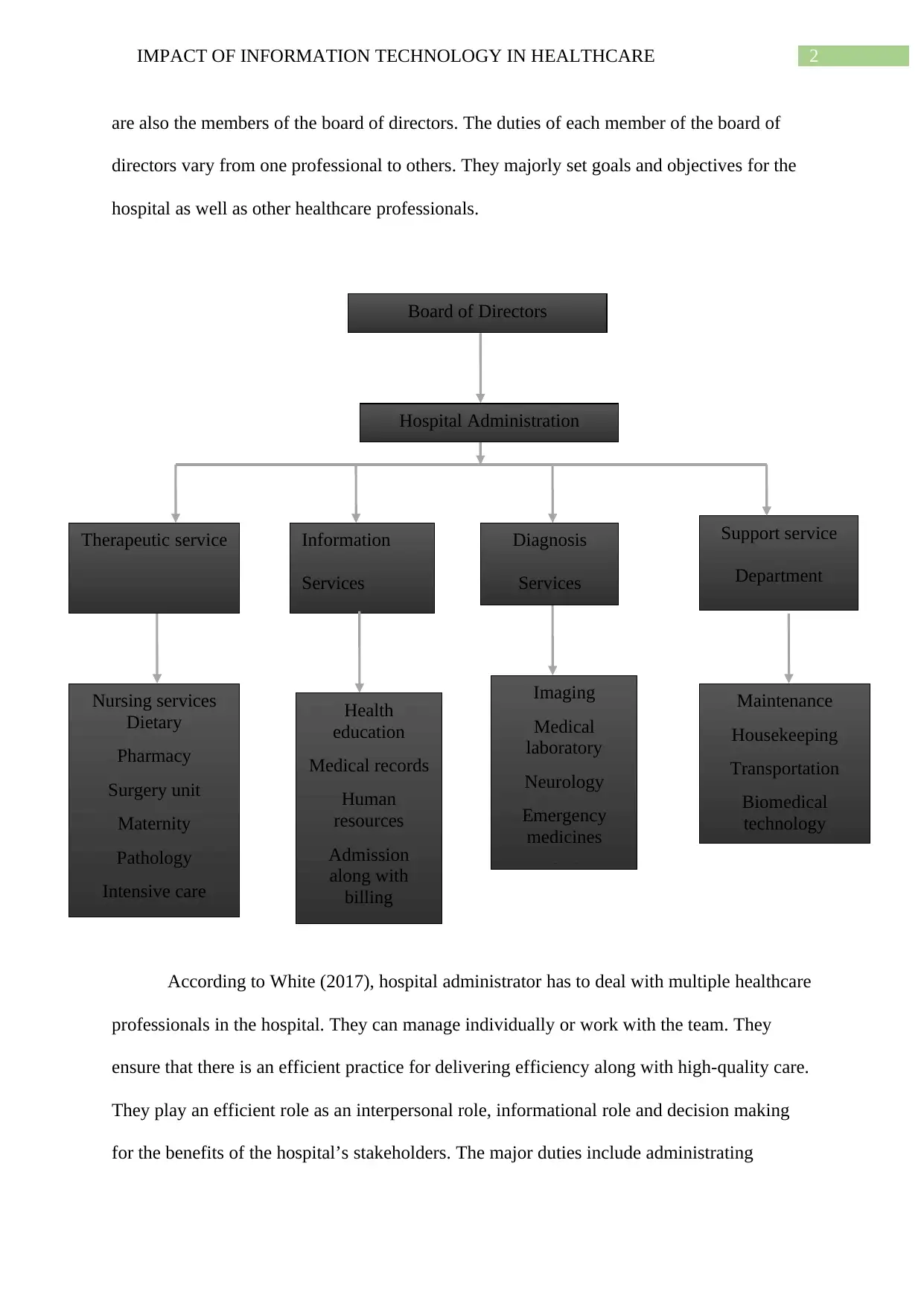
2IMPACT OF INFORMATION TECHNOLOGY IN HEALTHCARE
are also the members of the board of directors. The duties of each member of the board of
directors vary from one professional to others. They majorly set goals and objectives for the
hospital as well as other healthcare professionals.
According to White (2017), hospital administrator has to deal with multiple healthcare
professionals in the hospital. They can manage individually or work with the team. They
ensure that there is an efficient practice for delivering efficiency along with high-quality care.
They play an efficient role as an interpersonal role, informational role and decision making
for the benefits of the hospital’s stakeholders. The major duties include administrating
Board of Directors
Support service
Department
Therapeutic service Information
Services
Diagnosis
Services
Hospital Administration
Maintenance
Housekeeping
Transportation
Biomedical
technology
Imaging
Medical
laboratory
Neurology
Emergency
medicines
Cardiology
Health
education
Medical records
Human
resources
Admission
along with
billing
Nursing services
Dietary
Pharmacy
Surgery unit
Maternity
Pathology
Intensive care
are also the members of the board of directors. The duties of each member of the board of
directors vary from one professional to others. They majorly set goals and objectives for the
hospital as well as other healthcare professionals.
According to White (2017), hospital administrator has to deal with multiple healthcare
professionals in the hospital. They can manage individually or work with the team. They
ensure that there is an efficient practice for delivering efficiency along with high-quality care.
They play an efficient role as an interpersonal role, informational role and decision making
for the benefits of the hospital’s stakeholders. The major duties include administrating
Board of Directors
Support service
Department
Therapeutic service Information
Services
Diagnosis
Services
Hospital Administration
Maintenance
Housekeeping
Transportation
Biomedical
technology
Imaging
Medical
laboratory
Neurology
Emergency
medicines
Cardiology
Health
education
Medical records
Human
resources
Admission
along with
billing
Nursing services
Dietary
Pharmacy
Surgery unit
Maternity
Pathology
Intensive care
⊘ This is a preview!⊘
Do you want full access?
Subscribe today to unlock all pages.

Trusted by 1+ million students worldwide
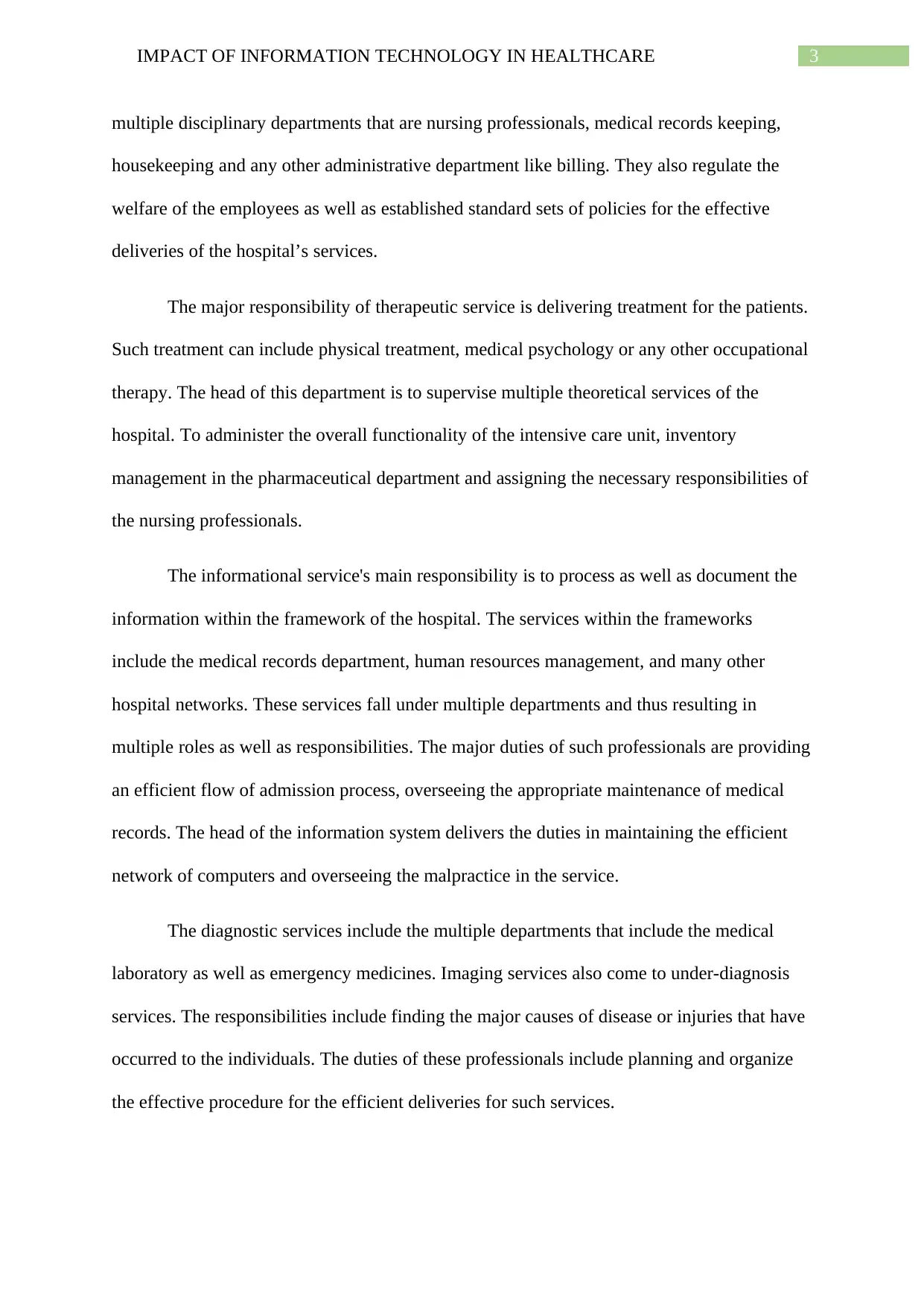
3IMPACT OF INFORMATION TECHNOLOGY IN HEALTHCARE
multiple disciplinary departments that are nursing professionals, medical records keeping,
housekeeping and any other administrative department like billing. They also regulate the
welfare of the employees as well as established standard sets of policies for the effective
deliveries of the hospital’s services.
The major responsibility of therapeutic service is delivering treatment for the patients.
Such treatment can include physical treatment, medical psychology or any other occupational
therapy. The head of this department is to supervise multiple theoretical services of the
hospital. To administer the overall functionality of the intensive care unit, inventory
management in the pharmaceutical department and assigning the necessary responsibilities of
the nursing professionals.
The informational service's main responsibility is to process as well as document the
information within the framework of the hospital. The services within the frameworks
include the medical records department, human resources management, and many other
hospital networks. These services fall under multiple departments and thus resulting in
multiple roles as well as responsibilities. The major duties of such professionals are providing
an efficient flow of admission process, overseeing the appropriate maintenance of medical
records. The head of the information system delivers the duties in maintaining the efficient
network of computers and overseeing the malpractice in the service.
The diagnostic services include the multiple departments that include the medical
laboratory as well as emergency medicines. Imaging services also come to under-diagnosis
services. The responsibilities include finding the major causes of disease or injuries that have
occurred to the individuals. The duties of these professionals include planning and organize
the effective procedure for the efficient deliveries for such services.
multiple disciplinary departments that are nursing professionals, medical records keeping,
housekeeping and any other administrative department like billing. They also regulate the
welfare of the employees as well as established standard sets of policies for the effective
deliveries of the hospital’s services.
The major responsibility of therapeutic service is delivering treatment for the patients.
Such treatment can include physical treatment, medical psychology or any other occupational
therapy. The head of this department is to supervise multiple theoretical services of the
hospital. To administer the overall functionality of the intensive care unit, inventory
management in the pharmaceutical department and assigning the necessary responsibilities of
the nursing professionals.
The informational service's main responsibility is to process as well as document the
information within the framework of the hospital. The services within the frameworks
include the medical records department, human resources management, and many other
hospital networks. These services fall under multiple departments and thus resulting in
multiple roles as well as responsibilities. The major duties of such professionals are providing
an efficient flow of admission process, overseeing the appropriate maintenance of medical
records. The head of the information system delivers the duties in maintaining the efficient
network of computers and overseeing the malpractice in the service.
The diagnostic services include the multiple departments that include the medical
laboratory as well as emergency medicines. Imaging services also come to under-diagnosis
services. The responsibilities include finding the major causes of disease or injuries that have
occurred to the individuals. The duties of these professionals include planning and organize
the effective procedure for the efficient deliveries for such services.
Paraphrase This Document
Need a fresh take? Get an instant paraphrase of this document with our AI Paraphraser
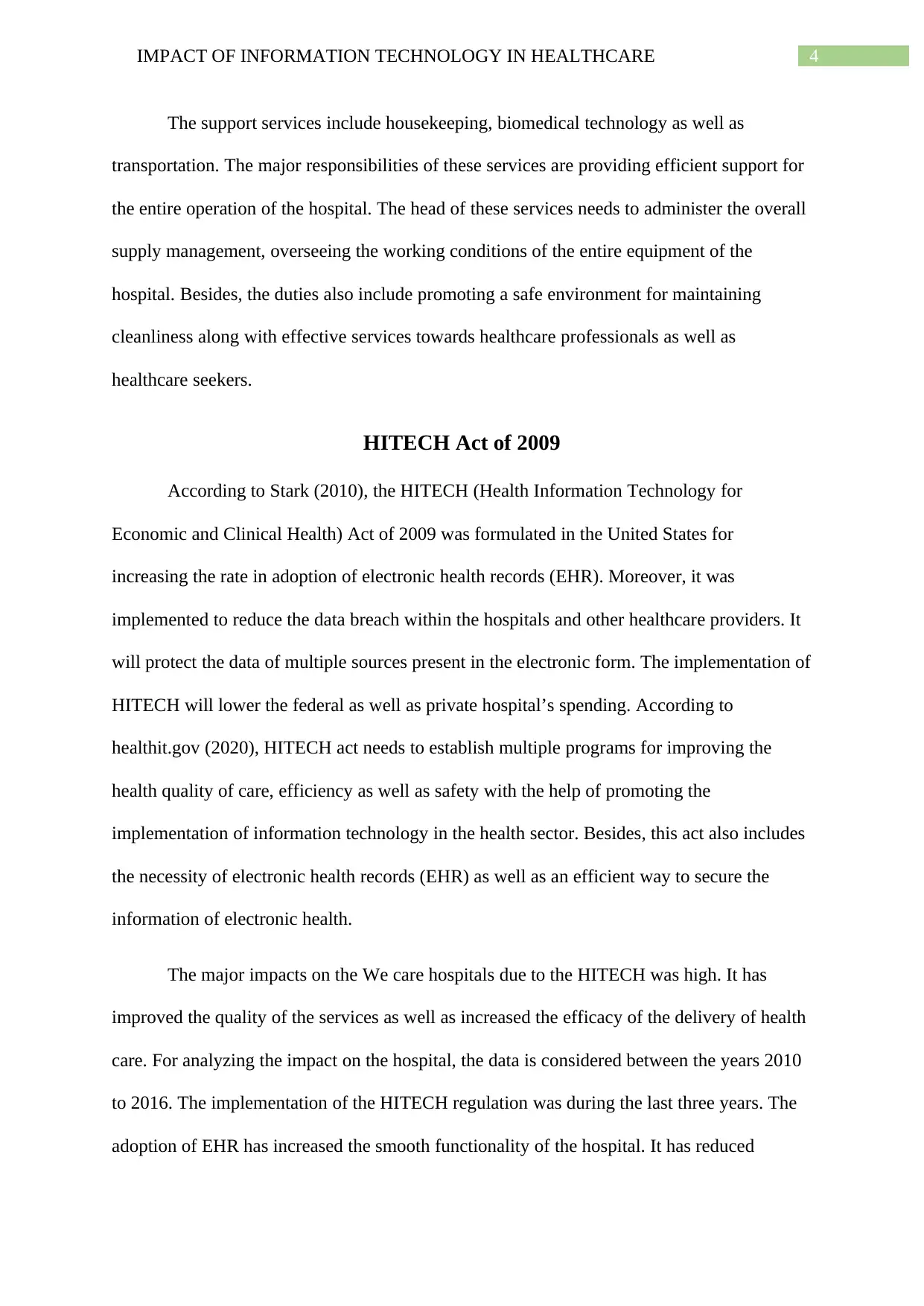
4IMPACT OF INFORMATION TECHNOLOGY IN HEALTHCARE
The support services include housekeeping, biomedical technology as well as
transportation. The major responsibilities of these services are providing efficient support for
the entire operation of the hospital. The head of these services needs to administer the overall
supply management, overseeing the working conditions of the entire equipment of the
hospital. Besides, the duties also include promoting a safe environment for maintaining
cleanliness along with effective services towards healthcare professionals as well as
healthcare seekers.
HITECH Act of 2009
According to Stark (2010), the HITECH (Health Information Technology for
Economic and Clinical Health) Act of 2009 was formulated in the United States for
increasing the rate in adoption of electronic health records (EHR). Moreover, it was
implemented to reduce the data breach within the hospitals and other healthcare providers. It
will protect the data of multiple sources present in the electronic form. The implementation of
HITECH will lower the federal as well as private hospital’s spending. According to
healthit.gov (2020), HITECH act needs to establish multiple programs for improving the
health quality of care, efficiency as well as safety with the help of promoting the
implementation of information technology in the health sector. Besides, this act also includes
the necessity of electronic health records (EHR) as well as an efficient way to secure the
information of electronic health.
The major impacts on the We care hospitals due to the HITECH was high. It has
improved the quality of the services as well as increased the efficacy of the delivery of health
care. For analyzing the impact on the hospital, the data is considered between the years 2010
to 2016. The implementation of the HITECH regulation was during the last three years. The
adoption of EHR has increased the smooth functionality of the hospital. It has reduced
The support services include housekeeping, biomedical technology as well as
transportation. The major responsibilities of these services are providing efficient support for
the entire operation of the hospital. The head of these services needs to administer the overall
supply management, overseeing the working conditions of the entire equipment of the
hospital. Besides, the duties also include promoting a safe environment for maintaining
cleanliness along with effective services towards healthcare professionals as well as
healthcare seekers.
HITECH Act of 2009
According to Stark (2010), the HITECH (Health Information Technology for
Economic and Clinical Health) Act of 2009 was formulated in the United States for
increasing the rate in adoption of electronic health records (EHR). Moreover, it was
implemented to reduce the data breach within the hospitals and other healthcare providers. It
will protect the data of multiple sources present in the electronic form. The implementation of
HITECH will lower the federal as well as private hospital’s spending. According to
healthit.gov (2020), HITECH act needs to establish multiple programs for improving the
health quality of care, efficiency as well as safety with the help of promoting the
implementation of information technology in the health sector. Besides, this act also includes
the necessity of electronic health records (EHR) as well as an efficient way to secure the
information of electronic health.
The major impacts on the We care hospitals due to the HITECH was high. It has
improved the quality of the services as well as increased the efficacy of the delivery of health
care. For analyzing the impact on the hospital, the data is considered between the years 2010
to 2016. The implementation of the HITECH regulation was during the last three years. The
adoption of EHR has increased the smooth functionality of the hospital. It has reduced
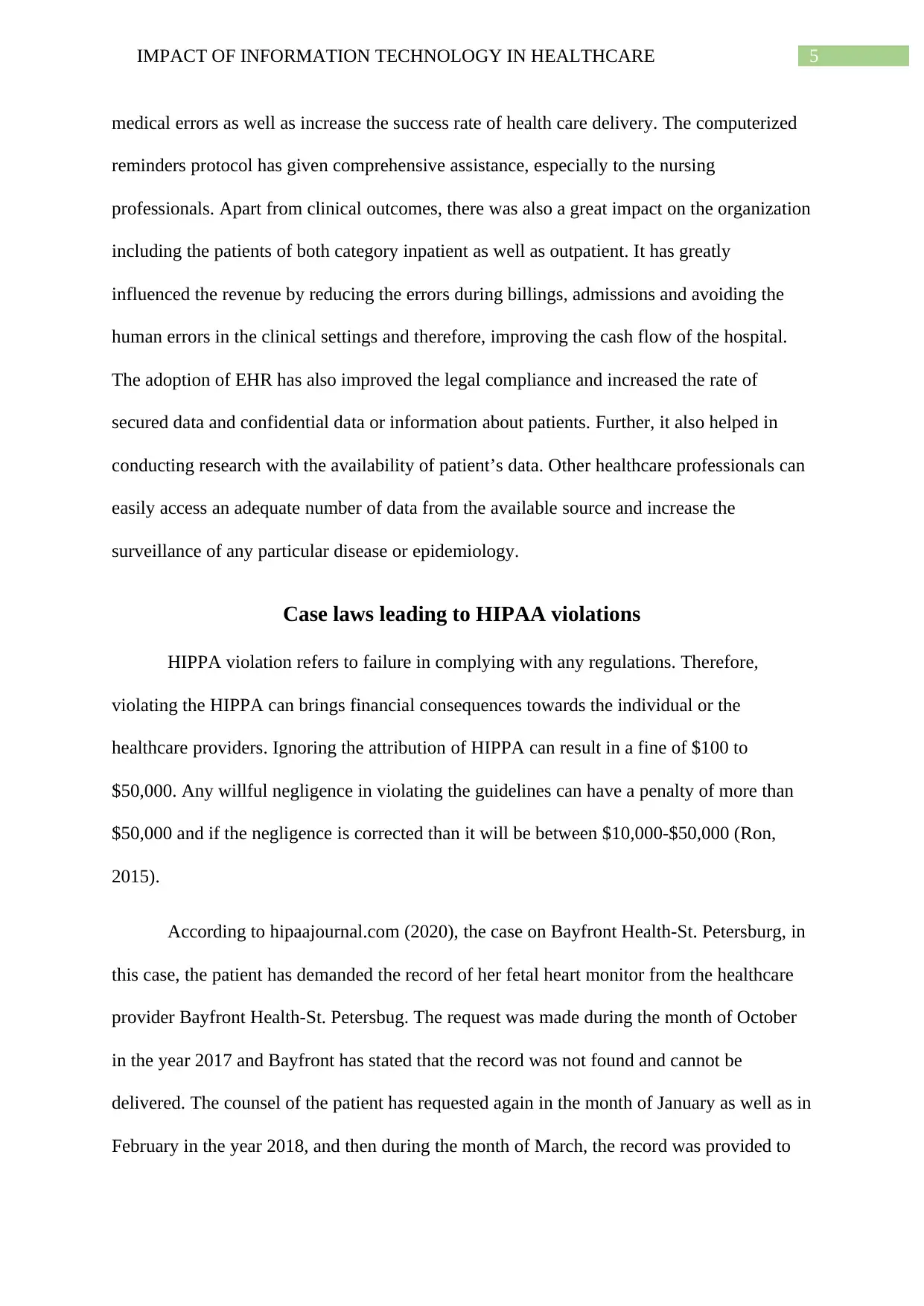
5IMPACT OF INFORMATION TECHNOLOGY IN HEALTHCARE
medical errors as well as increase the success rate of health care delivery. The computerized
reminders protocol has given comprehensive assistance, especially to the nursing
professionals. Apart from clinical outcomes, there was also a great impact on the organization
including the patients of both category inpatient as well as outpatient. It has greatly
influenced the revenue by reducing the errors during billings, admissions and avoiding the
human errors in the clinical settings and therefore, improving the cash flow of the hospital.
The adoption of EHR has also improved the legal compliance and increased the rate of
secured data and confidential data or information about patients. Further, it also helped in
conducting research with the availability of patient’s data. Other healthcare professionals can
easily access an adequate number of data from the available source and increase the
surveillance of any particular disease or epidemiology.
Case laws leading to HIPAA violations
HIPPA violation refers to failure in complying with any regulations. Therefore,
violating the HIPPA can brings financial consequences towards the individual or the
healthcare providers. Ignoring the attribution of HIPPA can result in a fine of $100 to
$50,000. Any willful negligence in violating the guidelines can have a penalty of more than
$50,000 and if the negligence is corrected than it will be between $10,000-$50,000 (Ron,
2015).
According to hipaajournal.com (2020), the case on Bayfront Health-St. Petersburg, in
this case, the patient has demanded the record of her fetal heart monitor from the healthcare
provider Bayfront Health-St. Petersbug. The request was made during the month of October
in the year 2017 and Bayfront has stated that the record was not found and cannot be
delivered. The counsel of the patient has requested again in the month of January as well as in
February in the year 2018, and then during the month of March, the record was provided to
medical errors as well as increase the success rate of health care delivery. The computerized
reminders protocol has given comprehensive assistance, especially to the nursing
professionals. Apart from clinical outcomes, there was also a great impact on the organization
including the patients of both category inpatient as well as outpatient. It has greatly
influenced the revenue by reducing the errors during billings, admissions and avoiding the
human errors in the clinical settings and therefore, improving the cash flow of the hospital.
The adoption of EHR has also improved the legal compliance and increased the rate of
secured data and confidential data or information about patients. Further, it also helped in
conducting research with the availability of patient’s data. Other healthcare professionals can
easily access an adequate number of data from the available source and increase the
surveillance of any particular disease or epidemiology.
Case laws leading to HIPAA violations
HIPPA violation refers to failure in complying with any regulations. Therefore,
violating the HIPPA can brings financial consequences towards the individual or the
healthcare providers. Ignoring the attribution of HIPPA can result in a fine of $100 to
$50,000. Any willful negligence in violating the guidelines can have a penalty of more than
$50,000 and if the negligence is corrected than it will be between $10,000-$50,000 (Ron,
2015).
According to hipaajournal.com (2020), the case on Bayfront Health-St. Petersburg, in
this case, the patient has demanded the record of her fetal heart monitor from the healthcare
provider Bayfront Health-St. Petersbug. The request was made during the month of October
in the year 2017 and Bayfront has stated that the record was not found and cannot be
delivered. The counsel of the patient has requested again in the month of January as well as in
February in the year 2018, and then during the month of March, the record was provided to
⊘ This is a preview!⊘
Do you want full access?
Subscribe today to unlock all pages.

Trusted by 1+ million students worldwide
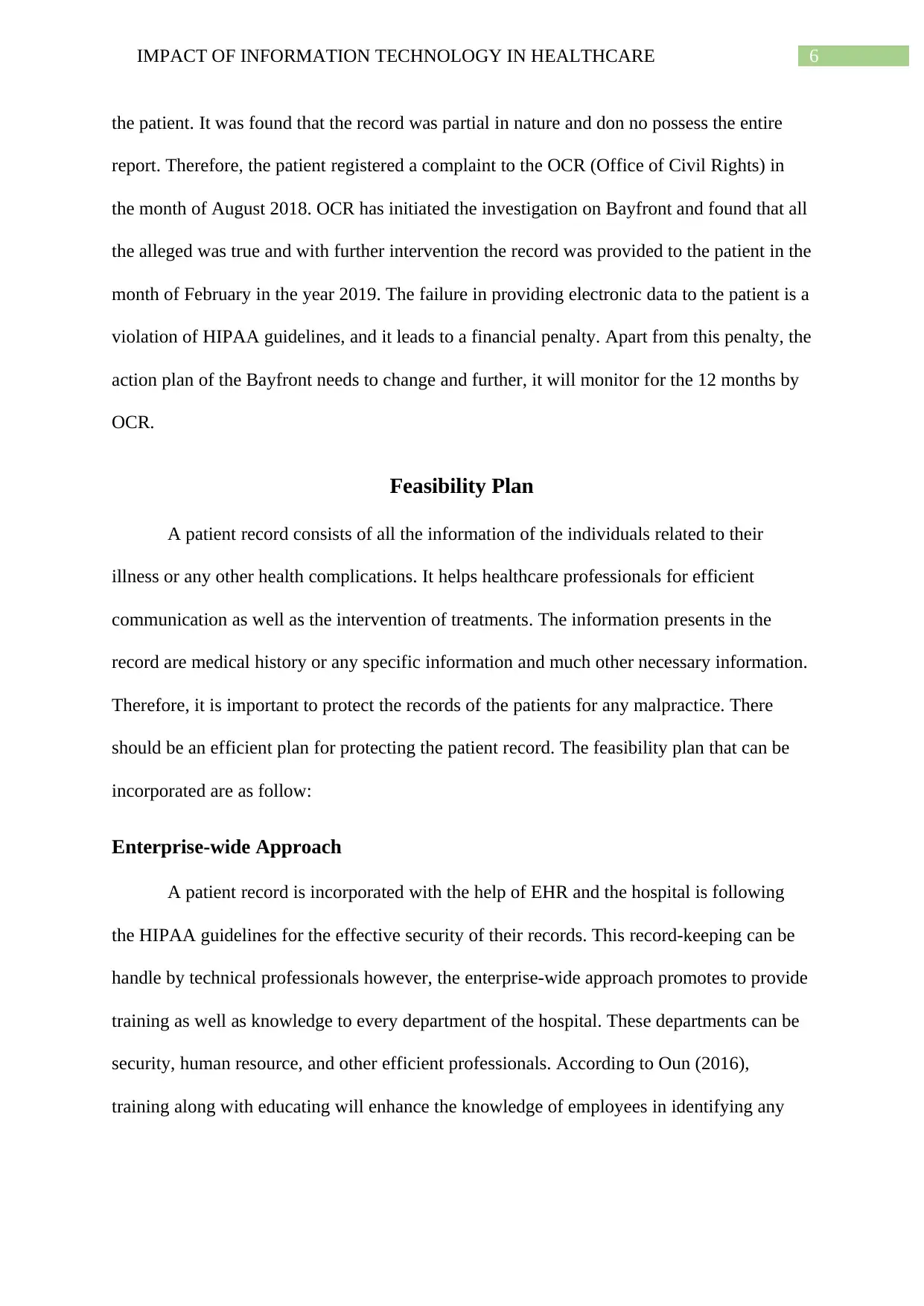
6IMPACT OF INFORMATION TECHNOLOGY IN HEALTHCARE
the patient. It was found that the record was partial in nature and don no possess the entire
report. Therefore, the patient registered a complaint to the OCR (Office of Civil Rights) in
the month of August 2018. OCR has initiated the investigation on Bayfront and found that all
the alleged was true and with further intervention the record was provided to the patient in the
month of February in the year 2019. The failure in providing electronic data to the patient is a
violation of HIPAA guidelines, and it leads to a financial penalty. Apart from this penalty, the
action plan of the Bayfront needs to change and further, it will monitor for the 12 months by
OCR.
Feasibility Plan
A patient record consists of all the information of the individuals related to their
illness or any other health complications. It helps healthcare professionals for efficient
communication as well as the intervention of treatments. The information presents in the
record are medical history or any specific information and much other necessary information.
Therefore, it is important to protect the records of the patients for any malpractice. There
should be an efficient plan for protecting the patient record. The feasibility plan that can be
incorporated are as follow:
Enterprise-wide Approach
A patient record is incorporated with the help of EHR and the hospital is following
the HIPAA guidelines for the effective security of their records. This record-keeping can be
handle by technical professionals however, the enterprise-wide approach promotes to provide
training as well as knowledge to every department of the hospital. These departments can be
security, human resource, and other efficient professionals. According to Oun (2016),
training along with educating will enhance the knowledge of employees in identifying any
the patient. It was found that the record was partial in nature and don no possess the entire
report. Therefore, the patient registered a complaint to the OCR (Office of Civil Rights) in
the month of August 2018. OCR has initiated the investigation on Bayfront and found that all
the alleged was true and with further intervention the record was provided to the patient in the
month of February in the year 2019. The failure in providing electronic data to the patient is a
violation of HIPAA guidelines, and it leads to a financial penalty. Apart from this penalty, the
action plan of the Bayfront needs to change and further, it will monitor for the 12 months by
OCR.
Feasibility Plan
A patient record consists of all the information of the individuals related to their
illness or any other health complications. It helps healthcare professionals for efficient
communication as well as the intervention of treatments. The information presents in the
record are medical history or any specific information and much other necessary information.
Therefore, it is important to protect the records of the patients for any malpractice. There
should be an efficient plan for protecting the patient record. The feasibility plan that can be
incorporated are as follow:
Enterprise-wide Approach
A patient record is incorporated with the help of EHR and the hospital is following
the HIPAA guidelines for the effective security of their records. This record-keeping can be
handle by technical professionals however, the enterprise-wide approach promotes to provide
training as well as knowledge to every department of the hospital. These departments can be
security, human resource, and other efficient professionals. According to Oun (2016),
training along with educating will enhance the knowledge of employees in identifying any
Paraphrase This Document
Need a fresh take? Get an instant paraphrase of this document with our AI Paraphraser

7IMPACT OF INFORMATION TECHNOLOGY IN HEALTHCARE
thefts or any breach. Efficient awareness of warning signs or any best practices will increase
the safety of patient records.
Risk Assessment
Apart from the HIPAA guidelines as well as their security rules, it is important to
analyze the risk within the hospital. It can be performed in a period of six months or annually.
However, it can impact the cost and therefore, can be analyzed annually. The internal risk
assessment will enable the reduction of loss of any patient data as well as efficiently manage
the data (Aven, 2016).
Encryption
The data should be encrypted for the efficiency of the high security of recording the
data. The data or records should be encrypted and there should be additional programs for
defending the firewalls (Abdulrahman, Poh & Burnett, 2014). Therefore, resulting in
protecting the security as well as privacy of the patient's data.
The feasibility plan needs to implement in the hospital for reducing the loss of the
patient record. Moreover, it also helps in reducing the thefts from the external environments.
The major threats of patient records are losing the data and misuse of records for some other
malpractice. Therefore, the enterprise-wide approach will enable the knowledge and
necessary steps to be taken during any such scenario. The risk assessment will forecast any
future possible threats and any other vulnerable factors. Encryption is the best way for
reducing the risk of losing any patient record.
Information Technology in Healthcare
The healthcare industry is continuously evolving in nature and the adaption of
information technology in the operational activities of a hospital or any other healthcare
provider brings effective deliveries of services. The foremost impact is efficient
thefts or any breach. Efficient awareness of warning signs or any best practices will increase
the safety of patient records.
Risk Assessment
Apart from the HIPAA guidelines as well as their security rules, it is important to
analyze the risk within the hospital. It can be performed in a period of six months or annually.
However, it can impact the cost and therefore, can be analyzed annually. The internal risk
assessment will enable the reduction of loss of any patient data as well as efficiently manage
the data (Aven, 2016).
Encryption
The data should be encrypted for the efficiency of the high security of recording the
data. The data or records should be encrypted and there should be additional programs for
defending the firewalls (Abdulrahman, Poh & Burnett, 2014). Therefore, resulting in
protecting the security as well as privacy of the patient's data.
The feasibility plan needs to implement in the hospital for reducing the loss of the
patient record. Moreover, it also helps in reducing the thefts from the external environments.
The major threats of patient records are losing the data and misuse of records for some other
malpractice. Therefore, the enterprise-wide approach will enable the knowledge and
necessary steps to be taken during any such scenario. The risk assessment will forecast any
future possible threats and any other vulnerable factors. Encryption is the best way for
reducing the risk of losing any patient record.
Information Technology in Healthcare
The healthcare industry is continuously evolving in nature and the adaption of
information technology in the operational activities of a hospital or any other healthcare
provider brings effective deliveries of services. The foremost impact is efficient
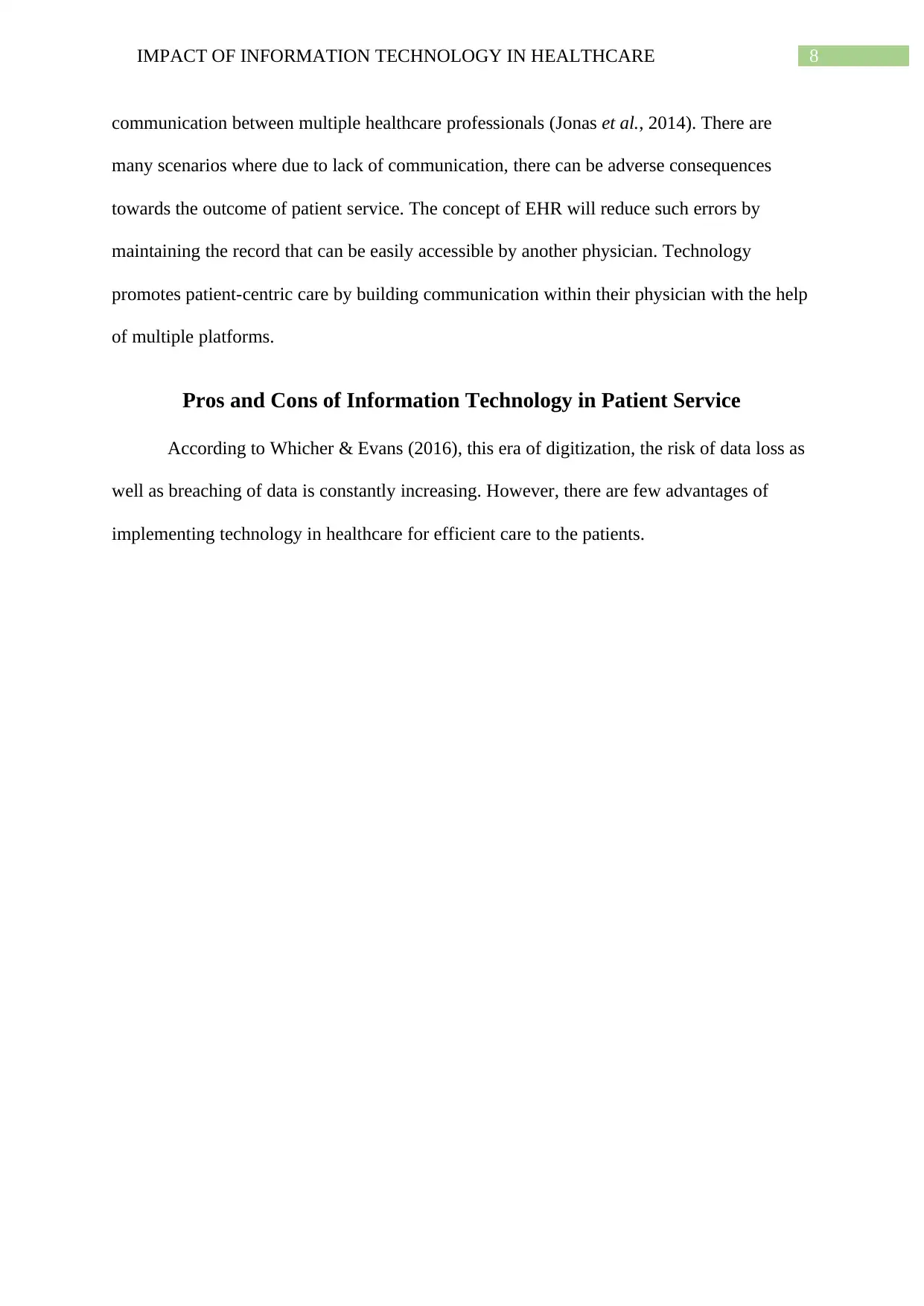
8IMPACT OF INFORMATION TECHNOLOGY IN HEALTHCARE
communication between multiple healthcare professionals (Jonas et al., 2014). There are
many scenarios where due to lack of communication, there can be adverse consequences
towards the outcome of patient service. The concept of EHR will reduce such errors by
maintaining the record that can be easily accessible by another physician. Technology
promotes patient-centric care by building communication within their physician with the help
of multiple platforms.
Pros and Cons of Information Technology in Patient Service
According to Whicher & Evans (2016), this era of digitization, the risk of data loss as
well as breaching of data is constantly increasing. However, there are few advantages of
implementing technology in healthcare for efficient care to the patients.
communication between multiple healthcare professionals (Jonas et al., 2014). There are
many scenarios where due to lack of communication, there can be adverse consequences
towards the outcome of patient service. The concept of EHR will reduce such errors by
maintaining the record that can be easily accessible by another physician. Technology
promotes patient-centric care by building communication within their physician with the help
of multiple platforms.
Pros and Cons of Information Technology in Patient Service
According to Whicher & Evans (2016), this era of digitization, the risk of data loss as
well as breaching of data is constantly increasing. However, there are few advantages of
implementing technology in healthcare for efficient care to the patients.
⊘ This is a preview!⊘
Do you want full access?
Subscribe today to unlock all pages.

Trusted by 1+ million students worldwide

9IMPACT OF INFORMATION TECHNOLOGY IN HEALTHCARE
Conclusion
From the above discussion, it can be concluded that the hospital needs to implement
information technology for effective patient service. However, it is important to follow the
guidelines of legislation for the quality of care towards the patients. The hospital
administrator has to work with multidisciplinary professionals for the effective
implementation of the practices and meeting the needs of healthcare providers as well as
healthcare seekers.
Conclusion
From the above discussion, it can be concluded that the hospital needs to implement
information technology for effective patient service. However, it is important to follow the
guidelines of legislation for the quality of care towards the patients. The hospital
administrator has to work with multidisciplinary professionals for the effective
implementation of the practices and meeting the needs of healthcare providers as well as
healthcare seekers.
Paraphrase This Document
Need a fresh take? Get an instant paraphrase of this document with our AI Paraphraser
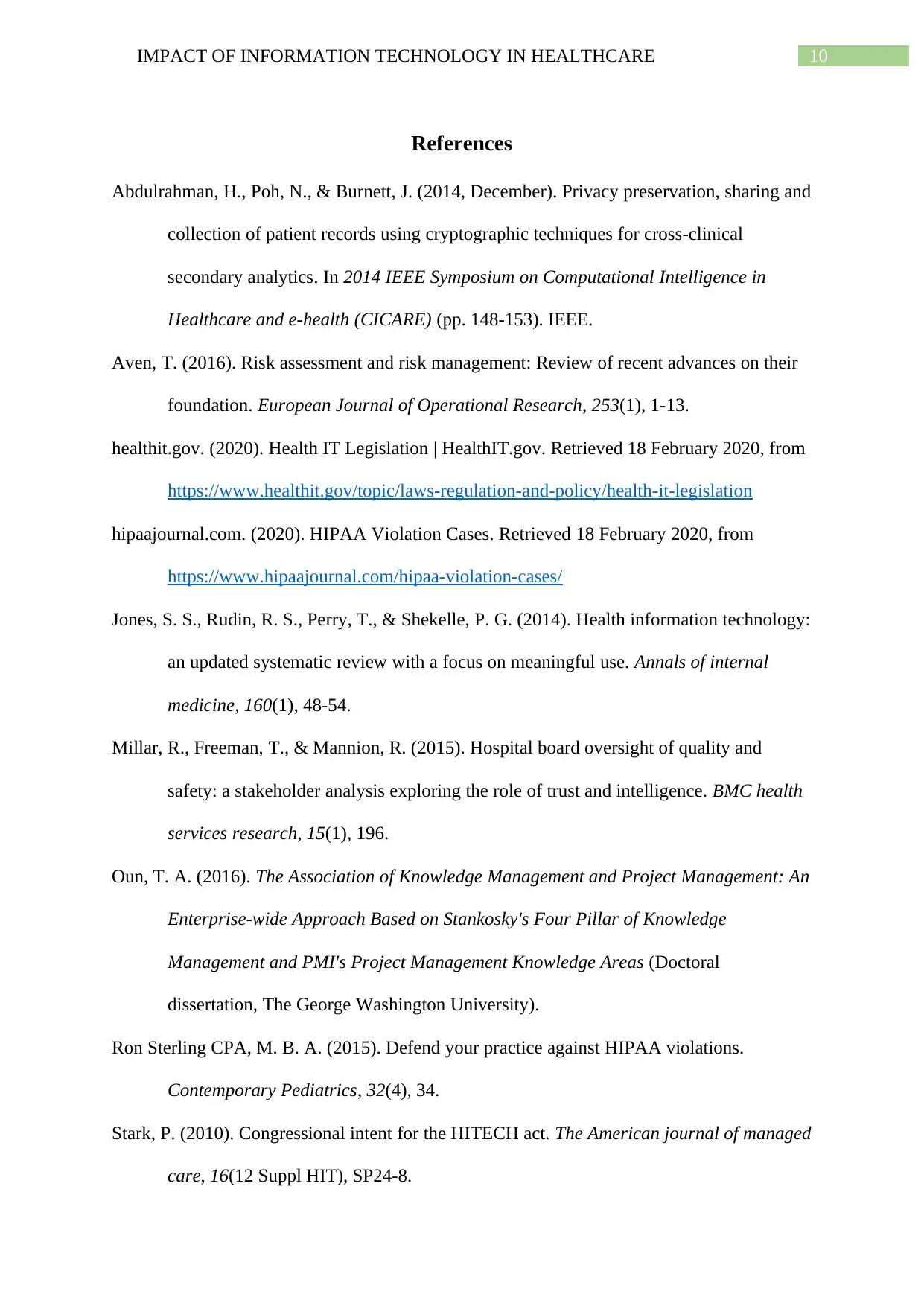
10IMPACT OF INFORMATION TECHNOLOGY IN HEALTHCARE
References
Abdulrahman, H., Poh, N., & Burnett, J. (2014, December). Privacy preservation, sharing and
collection of patient records using cryptographic techniques for cross-clinical
secondary analytics. In 2014 IEEE Symposium on Computational Intelligence in
Healthcare and e-health (CICARE) (pp. 148-153). IEEE.
Aven, T. (2016). Risk assessment and risk management: Review of recent advances on their
foundation. European Journal of Operational Research, 253(1), 1-13.
healthit.gov. (2020). Health IT Legislation | HealthIT.gov. Retrieved 18 February 2020, from
https://www.healthit.gov/topic/laws-regulation-and-policy/health-it-legislation
hipaajournal.com. (2020). HIPAA Violation Cases. Retrieved 18 February 2020, from
https://www.hipaajournal.com/hipaa-violation-cases/
Jones, S. S., Rudin, R. S., Perry, T., & Shekelle, P. G. (2014). Health information technology:
an updated systematic review with a focus on meaningful use. Annals of internal
medicine, 160(1), 48-54.
Millar, R., Freeman, T., & Mannion, R. (2015). Hospital board oversight of quality and
safety: a stakeholder analysis exploring the role of trust and intelligence. BMC health
services research, 15(1), 196.
Oun, T. A. (2016). The Association of Knowledge Management and Project Management: An
Enterprise-wide Approach Based on Stankosky's Four Pillar of Knowledge
Management and PMI's Project Management Knowledge Areas (Doctoral
dissertation, The George Washington University).
Ron Sterling CPA, M. B. A. (2015). Defend your practice against HIPAA violations.
Contemporary Pediatrics, 32(4), 34.
Stark, P. (2010). Congressional intent for the HITECH act. The American journal of managed
care, 16(12 Suppl HIT), SP24-8.
References
Abdulrahman, H., Poh, N., & Burnett, J. (2014, December). Privacy preservation, sharing and
collection of patient records using cryptographic techniques for cross-clinical
secondary analytics. In 2014 IEEE Symposium on Computational Intelligence in
Healthcare and e-health (CICARE) (pp. 148-153). IEEE.
Aven, T. (2016). Risk assessment and risk management: Review of recent advances on their
foundation. European Journal of Operational Research, 253(1), 1-13.
healthit.gov. (2020). Health IT Legislation | HealthIT.gov. Retrieved 18 February 2020, from
https://www.healthit.gov/topic/laws-regulation-and-policy/health-it-legislation
hipaajournal.com. (2020). HIPAA Violation Cases. Retrieved 18 February 2020, from
https://www.hipaajournal.com/hipaa-violation-cases/
Jones, S. S., Rudin, R. S., Perry, T., & Shekelle, P. G. (2014). Health information technology:
an updated systematic review with a focus on meaningful use. Annals of internal
medicine, 160(1), 48-54.
Millar, R., Freeman, T., & Mannion, R. (2015). Hospital board oversight of quality and
safety: a stakeholder analysis exploring the role of trust and intelligence. BMC health
services research, 15(1), 196.
Oun, T. A. (2016). The Association of Knowledge Management and Project Management: An
Enterprise-wide Approach Based on Stankosky's Four Pillar of Knowledge
Management and PMI's Project Management Knowledge Areas (Doctoral
dissertation, The George Washington University).
Ron Sterling CPA, M. B. A. (2015). Defend your practice against HIPAA violations.
Contemporary Pediatrics, 32(4), 34.
Stark, P. (2010). Congressional intent for the HITECH act. The American journal of managed
care, 16(12 Suppl HIT), SP24-8.
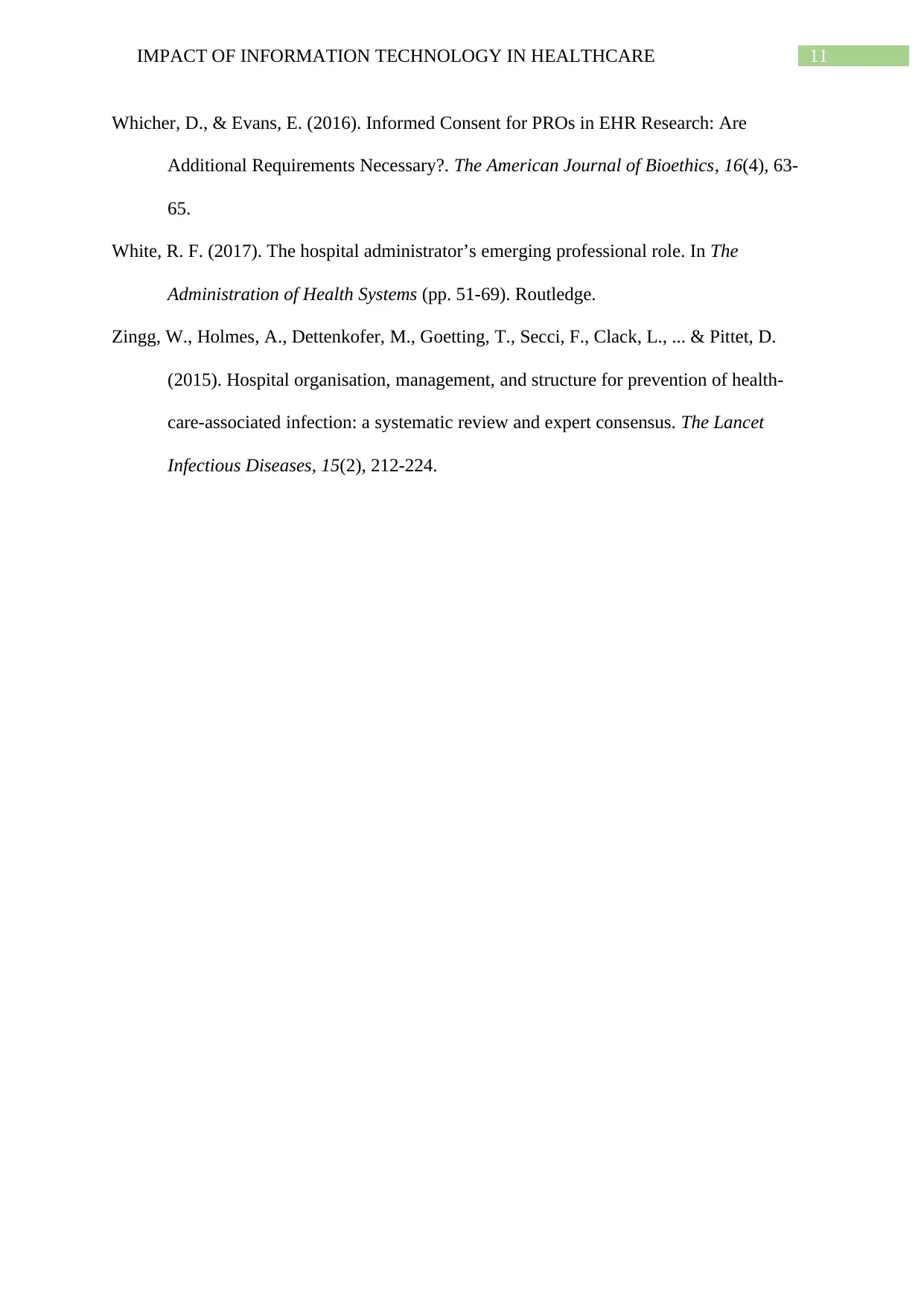
11IMPACT OF INFORMATION TECHNOLOGY IN HEALTHCARE
Whicher, D., & Evans, E. (2016). Informed Consent for PROs in EHR Research: Are
Additional Requirements Necessary?. The American Journal of Bioethics, 16(4), 63-
65.
White, R. F. (2017). The hospital administrator’s emerging professional role. In The
Administration of Health Systems (pp. 51-69). Routledge.
Zingg, W., Holmes, A., Dettenkofer, M., Goetting, T., Secci, F., Clack, L., ... & Pittet, D.
(2015). Hospital organisation, management, and structure for prevention of health-
care-associated infection: a systematic review and expert consensus. The Lancet
Infectious Diseases, 15(2), 212-224.
Whicher, D., & Evans, E. (2016). Informed Consent for PROs in EHR Research: Are
Additional Requirements Necessary?. The American Journal of Bioethics, 16(4), 63-
65.
White, R. F. (2017). The hospital administrator’s emerging professional role. In The
Administration of Health Systems (pp. 51-69). Routledge.
Zingg, W., Holmes, A., Dettenkofer, M., Goetting, T., Secci, F., Clack, L., ... & Pittet, D.
(2015). Hospital organisation, management, and structure for prevention of health-
care-associated infection: a systematic review and expert consensus. The Lancet
Infectious Diseases, 15(2), 212-224.
⊘ This is a preview!⊘
Do you want full access?
Subscribe today to unlock all pages.

Trusted by 1+ million students worldwide
1 out of 12
Related Documents
Your All-in-One AI-Powered Toolkit for Academic Success.
+13062052269
info@desklib.com
Available 24*7 on WhatsApp / Email
![[object Object]](/_next/static/media/star-bottom.7253800d.svg)
Unlock your academic potential
Copyright © 2020–2025 A2Z Services. All Rights Reserved. Developed and managed by ZUCOL.





